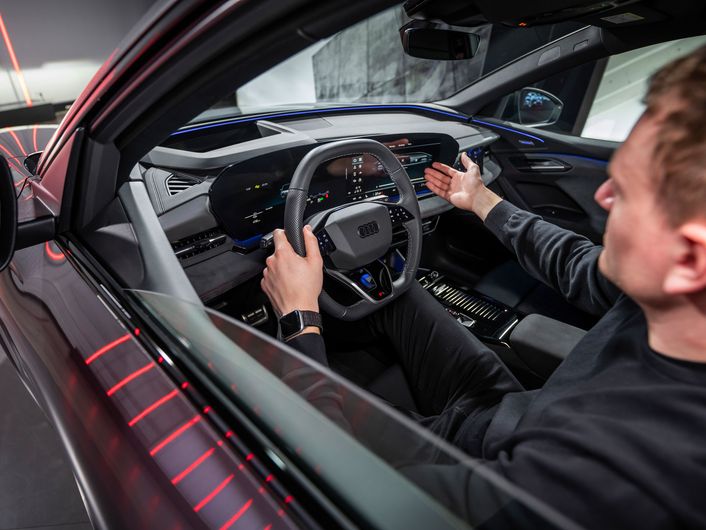Electrifying automobile in custom suit

Audi has already wrapped more than 20 prototypes and one-offs in unique foil – including the prototype of the Audi Q6 e-tron. Designer Marco dos Santos provides exclusive insights into how the expressive design is created and the philosophy behind it.
The pen in Marco dos Santos’ hand glides across the paper – large-scale graphics in Gloss Fierce Fuchsia, a purple hue, meet detailed mesh and stripe graphics in silver. It’s spring in Ingolstadt as the first ideas for the foil of the Audi Q6 e-tron prototype emerge on the sheet of paper. Marco dos Santos, who is responsible for Design Branding at Audi, peers over the rim of his lilac-tinted sunglasses, a podcast playing in the background. “When I'm drawing, I need a certain level of background noise. Sometimes it's easier to capture your ideas when your brain is busy doing something else entirely.” Then, says the designer, the pen in his hand moves almost automatically.
Audi prototypes and one-offs in custom suit

Audi prototypes and one-offs in custom suit
Since 2018, Audi prototypes and one-offs have received individual foils. The four rings also recently presented the S1 Hoonitron and the Formula 1 show car in the so-called livery design. Dos Santos dresses each model in a custom suit, so to speak. “It is one of a kind in the world, just for this exact model,” says the designer, who notes that expectations of car design have increased. “Our expectations in terms of design have increased enormously since we have all had high-performance cameras in our pockets. Aesthetics have become a fundamental part of our everyday lives, and that’s naturally reflected in the choice of things we use and surround ourselves with every day.”

Foil emphasizes key elements of vehicle architecture

Foil emphasizes key elements of vehicle architecture
The shapes and colors of the foil are intended to emphasize the key elements of the vehicle architecture. On the Audi Q6 e-tron, for example, the lower sill is set apart from the body in white. “Through the foil, we create opportunities on a prototype to talk about the design, which is actually still mostly secret,” dos Santos explains. “We can still be vague on one hand, while already deliberately going into more detail on certain things. Technology and design are closely intertwined. Technology is becoming increasingly powerful and precise and, using the Q6 e-tron as an example that’s also evident in the design, the choice of materials and the way the story is told.”

„
Inspiration can be found in the craziest objects“
Dos Santos never runs out of ideas; he also draws inspiration from everyday objects. “Whether it’s fashion, art, robotics or the ceramic tile in a friend’s kitchen: Inspiration to work with colors, materials or graphics can be found in the craziest objects,” he says. “And I think it's also important to look for it there, rather than just studying existing livery designs.”
Designers match foil to car
At the beginning of the design process, he decides together with his colleagues from Exterior Design which areas of the body should be particularly emphasized. Dos Santos: “In the case of a custom-made suit, for example, it’s the waistline or the shoulders. And with a vehicle, too, it’s all about the musculature and the distinctive shoulder line. Only when everything is perfectly matched to the person – or the car, for that matter – does a custom suit fit perfectly.”

The moment of truth in the design process
After many sketches by hand, dos Santos’ vision is finally applied to the vehicle using image and graphics software. The foiling process, which takes several days, requires the utmost precision. Munich-born dos Santos keeps a low profile during this process: “Unfortunately, I’m extremely clumsy and always observe this part of the work from a safe distance.” The foiling, he says, is the moment of truth. “Because previously geometrically straight lines quickly become crooked, skewed or overstretched when transferred to a car body with its curved surfaces.” At this stage of the work, “many things are discarded, reconsidered and redesigned.” Until everything fits one hundred percent, from every angle.
Dos Santos experiences his personal favorite moment in the design process when his vision takes shape. When his strokes on paper are transferred to the vehicle. When he senses that his idea is working. And when the custom suit is a perfect fit.

.jpg?imwidth=719&imdensity=1)


